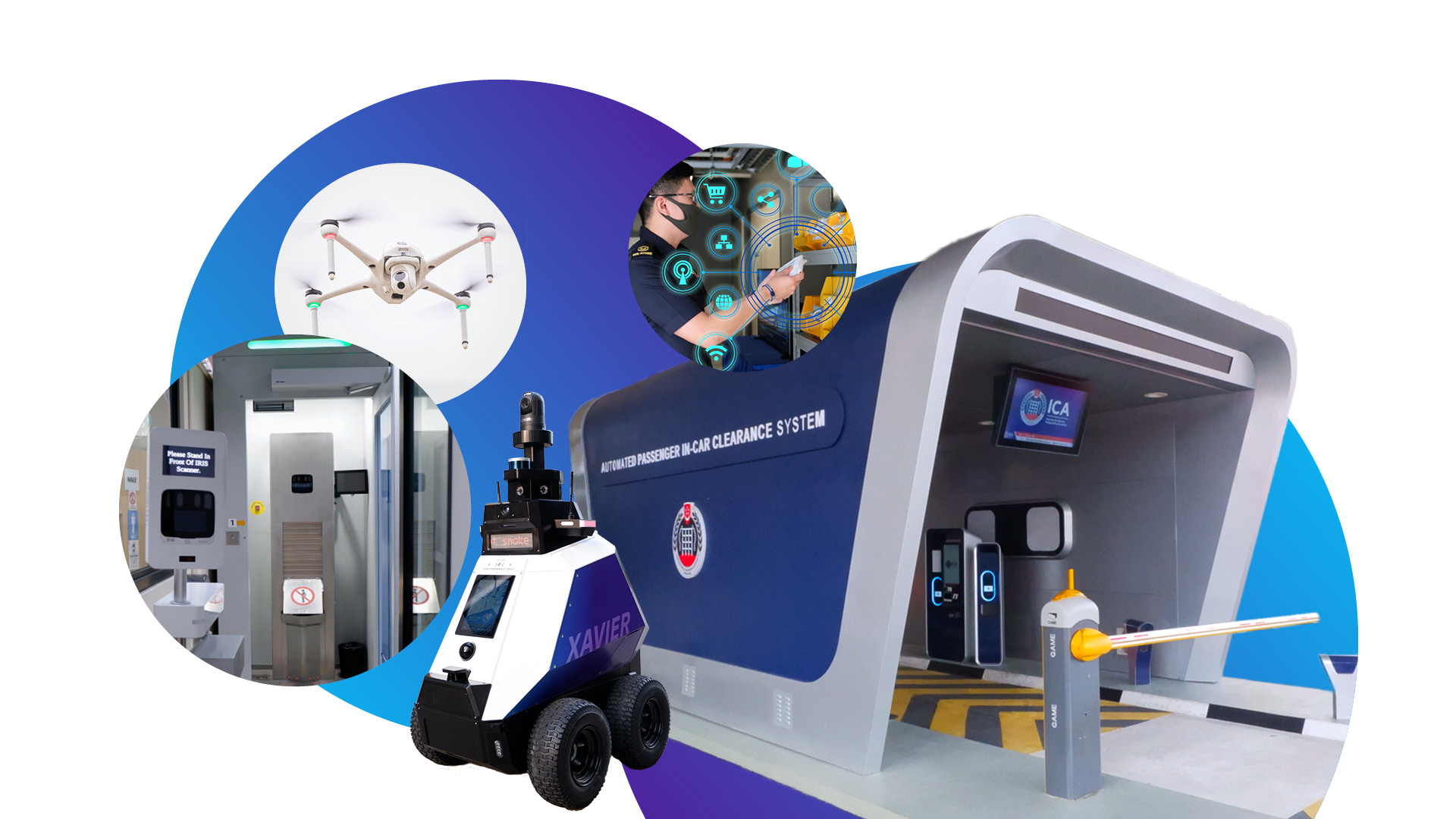From automation, to cloud technology, to digital twins, innovation is reshaping how HTX is working to keep Singapore safe and secure. HTX is integrating a diverse range of scientific and engineering capabilities to innovate and deliver transformative and operationally ready solutions for the Home Team. (Graphic: HTX/ Li Xin Hui)
HTX is integrating a diverse range of scientific and engineering capabilities to innovate and deliver transformative and operationally ready solutions for the Home Team. (Graphic: HTX/ Li Xin Hui)Digitalisation and innovation are rapidly transforming how we live and work. At HTX, engineers and scientists are embracing advancements in technology to empower the Home Team to operate effectively and impact exponentially.
Here are some key trends that are defining the future of work:
Doing more with less through automation (Clockwise from top left) Drone, Automated Medical Store, autonomous ground robot Xavier, and the Prison Automated Screening System. (Graphic: HTX/ Li Xin Hui)
(Clockwise from top left) Drone, Automated Medical Store, autonomous ground robot Xavier, and the Prison Automated Screening System. (Graphic: HTX/ Li Xin Hui)An
automated passenger in-car clearance system that allows you to breeze through immigration clearance on your own. A
screening system that automatically collects urine samples and tests them for illicit drugs. A
robot with autonomous patrolling capabilities. A
drone that delivers Automated External Defibrillators (AEDs) to locations that are not easily accessible to help save lives. An
automated medical store for paramedics to grab-and-go.
These are just some examples of how
robotics and automation are enabling a myriad of possibilities to support Home Team officers in their work to keep Singapore safe and secure.
On the digital front, officers who frequently perform routine and repetitive tasks that are time-consuming and tedious, such as manual data entry or invoice certification, are turning to Robotics Process Automation (RPA), an application software robot that automates repetitive tasks in a fast and error-free manner.
Applying artificial intelligence (AI) to automate and assist
Applications of AI technologies span a wide spectrum from chatbots and virtual assistants, to recommendation systems such as that used by YouTube, to understanding human speech.
Speech-to-Text (STT), also known as automatic speech recognition, uses AI to convert audio/voice to text through signal processing and machine learning techniques.
An application of STT is the Automatic Speech Recognition for 995 emergency calls, a proof-of-concept by HTX, Nanyang Technological University, and the Singapore Civil Defence Force, which transcribes emergency calls in real-time, allowing officers to focus on listening to the details. It is a trilingual system that supports Singapore English, Malay, and Chinese. This is one of the first-of-its-kind as most other models are bilingual.
Other AI-enabled tools include natural language processing (NLP) tools that help to accurately extract or summarise information and insights in documents. These tools are designed to reduce the cognitive load of Home Team officers for tasks involving qualitative data.
HTX’s
CBRNE Centre of Expertise has also developed a tool called “eXaminer” that uses AI to automate the detection of anomalies and security threats in baggage and parcels on X-ray images, enabling image analysts to make more accurate assessments.
 Dr. Teo Soo Kng (extreme left), Senior Data Scientist, CBRNE CoE, explaining how eXaminer identifies threats of interest based on X-ray images. Behind him is the display from eXaminer, which highlights suspicious items being screened. (Photo: HTX)Heading to the cloud to scale and innovate
Dr. Teo Soo Kng (extreme left), Senior Data Scientist, CBRNE CoE, explaining how eXaminer identifies threats of interest based on X-ray images. Behind him is the display from eXaminer, which highlights suspicious items being screened. (Photo: HTX)Heading to the cloud to scale and innovateCloud computing is powering new digital capabilities, reducing time-to-market, and providing responsive scalability to meet changing demand. Infrastructure as a Service (IaaS), Platform as a Service (PaaS), and Software as a Service (SaaS), are three main cloud service models that allow teams to customise the resources they need for their projects and focus on building.
Everyone can innovate and turn their ideas into solutions using no-code or low-code platforms such as the Microsoft Power platform. New mobile and web applications can be developed quickly and easily, with little or no coding skills needed.
Read related article: Clout of the CloudDigital twins to boost predictive capabilities Screenshot of an autonomous ground robot navigating in a virtual world replica of the area around HTX headquarters within the digital twin. (Screenshot: HTX/ Stacia Chua)
Screenshot of an autonomous ground robot navigating in a virtual world replica of the area around HTX headquarters within the digital twin. (Screenshot: HTX/ Stacia Chua)With digital twins – a digital representation of a real-world object, process, or system – it is possible to run simulations and tests quickly and repeatedly. HTX’s
Robotics, Automation & Unmanned Systems Centre of Expertise has embarked on Project Venture to explore the development of a digital twin for unmanned system applications.
Developing the autonomous capabilities of unmanned systems is an iterative process that requires a lot of data to support machine learning, as well as extensive ground testing to assess the performance and ensure the reliability of the unmanned system.
Using a digital twin for a robot, RAUS engineers can put the virtual robot through simulations and test the robot’s response. For example, instead of physically testing how a robot’s sensors respond to light at different times of the day repeatedly to understand the impact to its system, this can now be simulated virtually.
Read related article: Exploring exciting innovations at HTX TechXplore 4